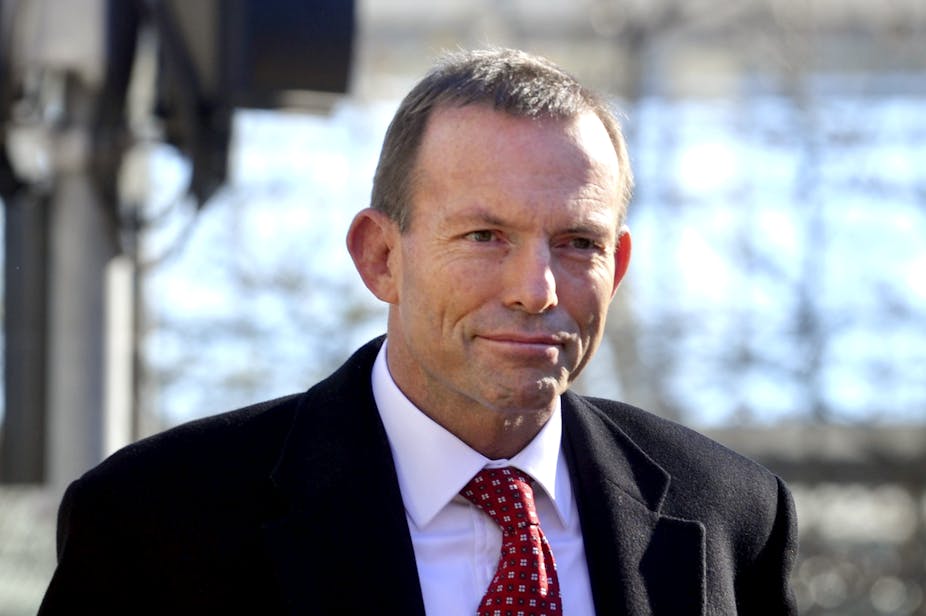Federal Opposition Leader Tony Abbott today announced $430 million in to boost support mentally ill Australians in the workforce with employment services, research and professional development.
It’s an outstanding set of announcements. If you buy the line that there’s not a lot of spending capacity in the forthcoming federal budget, Tony Abbott’s policies are very select, strategically smart and will make a transformative difference for access to mental health services.
Why do so many mentally ill Australians struggle to maintain employment?
This is a critical policy issue for all Australian governments over the next decade. We’re clearly facing a skills shortage and that’s across the board, it’s not just in the mining sector.
We have to get a lot better at engaging people of working age who are not in employment.
Mental illness, often untreated, is one of the primary causes for the situation that we face.
About 28% of all Australians on the disability support pension have a primary mental health-based disability. Of the remaining 70%, around half have mental health problems as a secondary contributor.
The rate of employment for people with mental health conditions in OECD nations is nearly three times the rate of employment than Australia. Needless to say, Australia does very poorly in this area.
There are a number of reasons for this and the announcement by the Federal Opposition this morning starts to address some of these issues.
How does the Coalition’s announcement build on existing infrastructure?
We’re already spending a lot of money increasing employment services for people with mental health disorders.
Commonwealth spending on disability support pensions and employment-related programs is around $5 billion. This provides income and support for people on the disability support pension, Newstart allowance and other benefits who are there because of mental health problems. But we’re not getting good outcomes from that spending.
What today’s announcement does is target a couple of specific areas where we know we can do better.
It’s not just a matter of preparing a person with significant mental illness to enter the workplace.
We need to place people in a workplace where they can receive support. A truly supportive work environment is where the culture recognises the way mental illness presents and manifests.
These workplaces support the employer to help keep that person engaged, modify activities, train co-workers on how to deal with mental health episodes and crises if they occur, and retain that person in employment.
The mental health blueprint, released last month, calls for a minimum investment across 30 targeted programs over four years.
We’ve got to lift our current rate of mental health funding as a proportion of total health spending - from around 6% towards 12% to 13%.
That’s a very big ask and no government of any persuasion is going to be able to do that in one or two terms. I think the Coalition is mindful that what was announced today is not enough.
Will we see more than just a bidding war from today’s announcements?
I have to be optimistic that this announcement is more than a bidding war. I certainly believe what the Coalition took to the last election and what they’re building on today could bring about real improvements.
The Rudd Government and, to an extent, the Gillard Government are “blowhards” when it comes to mental health. They’ve talked long and hard but they’ve delivered almost nothing.
Suicide prevention was the cornerstone of their mental health policy leading into the last election, with promises of spending $274m over four years.
In the first year, they’ve spent $10m. There’s a bit of a credibility gap when you say you’re going to deal with an issue and in the first year you spend only 2% of the funding that you’ve allocated.
The situation is similar when we look at the Headspace initiatives for increasing early intervention sites around the country.
Labor is spending most of the money not in the second term, but in the third term of government if they’re re-elected. I think that is gilding the lily on this issue.
We need to see the investment flying through fairly evenly, but building up over the four-year budget cycle.
Tony Abbott has basically picked out elements of the blueprint that were released by the working group last month. Many of the working group’s members are advisors to the Federal Mental Health Minister Mark Butler.
These are things members of this group have said privately to the government about what needs to be done.
Tony Abbott has said, very wisely, we know we’ve got a problem with employment participation for people with mental illness and I’m going to target that because it’s one of the areas where investments will produce dividends. The impact on the budget in the longer term will be a positive one.
We know employment participation is critical to people’s recovery, in lifting them out of poverty and helping them regain their sense of self.
Certainly social inclusion is improved dramatically by participating in work. So I think it’s a wise investment, it’s a smart policy, and it won’t cost the budget bottom line in the first instance.
Over the longer term, it will save an enormous amount in terms of the money we’re spending at the moment on disability support pensions and the like.
We’re spending this money now but without getting any movement on people going back to employment.

